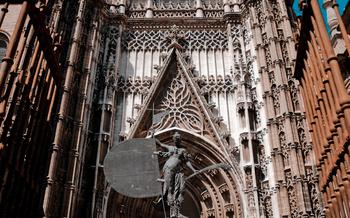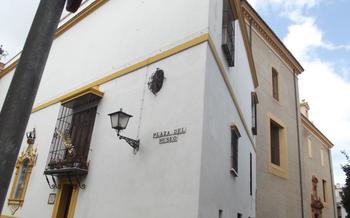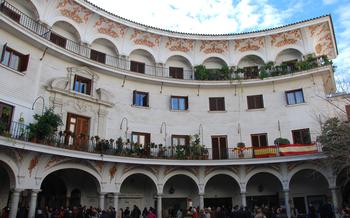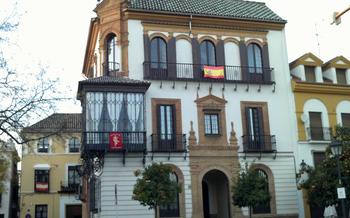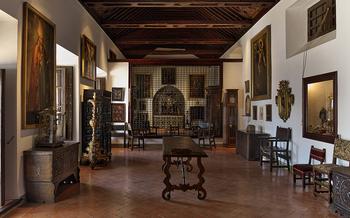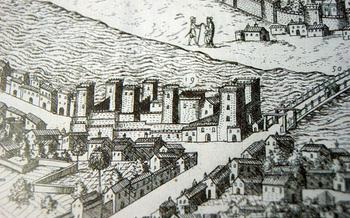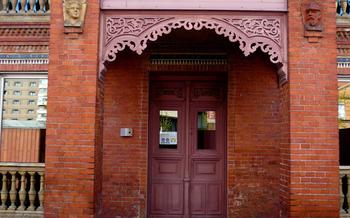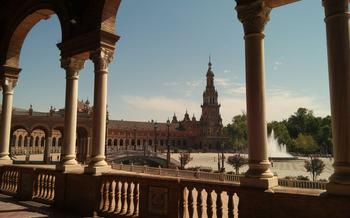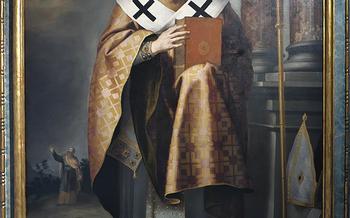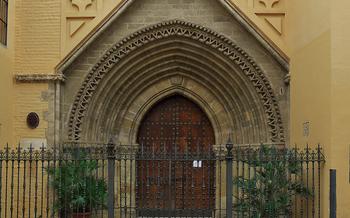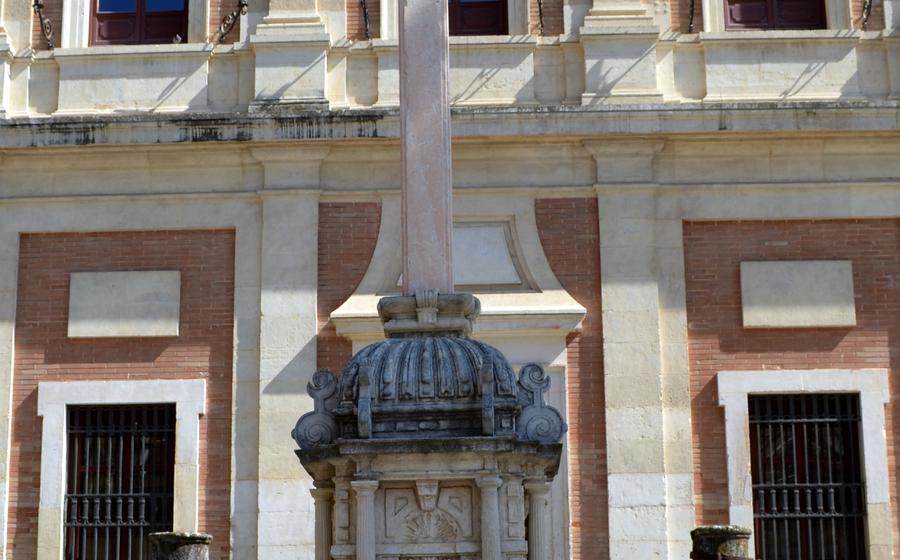
Archivo de Indias
- A World Heritage Site
- The Building and Its Architecture
- Collections and Exhibits
- Research and Scholarship
- Guided Tours and Educational Programs
- Visitor Information and Accessibility
- Location and Transportation
- Cultural Significance and Identity
- Local Legends and Stories
- Collaboration and Partnerships
- Digitalization and Online Access
- Conservation and Preservation
- Future Plans and Developments
- Insider Tip: Enhance Your Visit to the Archivo de Indias
A World Heritage Site
The Archivo de Indias' exceptional historical significance and the wealth of information it holds have earned it the prestigious designation of a UNESCO World Heritage Site. This esteemed recognition acknowledges the archive's outstanding universal value, not only for Spain but for the entire world. The criteria that led to this designation include the archive's authenticity and integrity, its exceptional representation of the history of the Spanish Empire, and its importance as a source of information for researchers and scholars. Preserving the archive's heritage for future generations is paramount, as it serves as a vital testament to Spain's colonial past and its global impact. The ongoing efforts to protect and maintain the archive ensure that this invaluable treasure remains accessible and continues to inspire and educate generations to come.
The Building and Its Architecture
The Archivo de Indias is housed in a striking Renaissance-style building that is considered one of Seville's architectural masterpieces. The building was constructed between 1572 and 1598 under the direction of the renowned architect Juan de Herrera, who was also responsible for designing the Monastery of San Lorenzo de El Escorial.
The building's fachada, or façade, is characterized by its symmetry and its use of classical elements such as columns, pilasters, and pediments. The main entrance is flanked by two large towers, while the upper floors are adorned with balconies and windows.
The interior of the building is equally impressive. The main courtyard, known as the Patio de los Naranjos, is surrounded by two-story arcades. The upper floor features a series of murals depicting scenes from the history of Spain's colonial empire.
The Archivo de Indias has undergone several renovations and expansions over the years. In the 18th century, a new wing was added to the building to accommodate the growing collection of documents. In the 19th century, the building was restored and modernized to better protect the collections.
Today, the Archivo de Indias is a UNESCO World Heritage Site and one of the most popular tourist attractions in Seville. The building's unique architecture and its rich history make it a must-see for anyone interested in Spanish colonial history and culture.
The ongoing restoration and conservation efforts at the Archivo de Indias are essential to preserving this architectural masterpiece for future generations. These efforts include cleaning and repairing the building's exterior, restoring the murals, and upgrading the security systems.
Thanks to these efforts, the Archivo de Indias continues to stand as a testament to the power and grandeur of Spain's colonial empire.
Collections and Exhibits
The Archivo de Indias houses a vast and diverse collection of documents, maps, and artifacts that provide invaluable insights into Spain's colonial history. These collections include:
-
Documents: The archive holds over 43,000 legajos (bundles) of documents, totaling approximately 80 million pages. These documents cover a wide range of topics, including royal decrees, administrative records, correspondence, financial statements, and legal documents.
-
Maps: The archive's collection of maps is one of the most extensive in the world, with over 8,000 maps dating from the 16th to the 19th centuries. These maps depict the Spanish Empire's vast territories in the Americas, Asia, and Africa.
-
Artifacts: In addition to documents and maps, the archive also houses a collection of artifacts related to Spain's colonial history. These artifacts include weapons, navigational instruments, coins, and religious objects.
The significance of these collections is immense. They provide a rich source of information for researchers studying Spain's colonial history, the history of the Americas, and the history of global exploration. The collections are also of great interest to genealogists, historians, and anyone interested in learning more about Spain's past.
The Archivo de Indias is committed to making its collections accessible to researchers and visitors. The archive's staff is available to assist researchers in their work and to provide guidance on how to access the collections. The archive also offers a variety of educational programs and exhibits that showcase its treasures to the public.
Research and Scholarship
The Archivo de Indias serves as a hub for historical research and scholarship, attracting scholars from around the world. Its vast collection of documents and artifacts provides researchers with a wealth of primary sources for studying Spain's colonial history. The archive's staff is dedicated to supporting researchers, providing access to its collections, and facilitating their research endeavors.
Scholars can access the archive's collections through a variety of means. The archive's online catalog allows researchers to search and identify relevant documents and artifacts. Once identified, researchers can request access to the materials in person or through interlibrary loan. The archive also offers a range of research services, including document reproduction, translation, and transcription.
In addition to its collections, the Archivo de Indias also hosts a variety of research events and programs. These events include conferences, workshops, and seminars, which provide scholars with opportunities to share their research findings and engage in discussions with colleagues. The archive also offers research grants and fellowships to support scholars pursuing research related to its collections.
The research conducted at the Archivo de Indias has had a profound impact on our understanding of Spain's colonial history. Scholars have used the archive's collections to study a wide range of topics, including the Spanish conquest of the Americas, the administration of the Spanish colonies, and the impact of colonialism on indigenous populations. The research conducted at the archive has helped to shape our understanding of the complex and multifaceted nature of Spain's colonial empire.
Guided Tours and Educational Programs
The Archivo de Indias offers a range of guided tours tailored to visitors of all interests and knowledge levels. These informative and engaging tours provide an immersive experience, allowing visitors to delve into the stories and significance of the archive's collections. Led by knowledgeable and enthusiastic guides, the tours cover a variety of topics, including the history of the archive, the processes of document preservation, and the key moments in Spain's colonial past.
For those wishing to delve deeper, the archive also offers educational programs designed for students and educators. These programs provide a unique opportunity for participants to engage with primary sources, explore historical themes, and develop research skills. Through workshops, seminars, and interactive activities, the archive's educational programs foster a deeper understanding of Spain's colonial history and its global impact.
By offering guided tours and educational programs, the Archivo de Indias plays a vital role in promoting awareness and appreciation of history. These initiatives not only enhance the visitor experience but also contribute to the ongoing preservation and dissemination of Spain's rich cultural heritage.
Visitor Information and Accessibility
The Archivo de Indias is open to the public from Monday to Friday, with extended hours on Thursdays. Admission fees are charged, with discounts available for students, seniors, and groups. The archive is accessible for visitors with disabilities, with wheelchair ramps and elevators providing access to all levels of the building. Multilingual guides and resources are available to assist visitors from around the world. The archive also offers a variety of visitor services and amenities, including a cloakroom, a gift shop, and a café.
Insider Tip:
To make the most of your visit, plan ahead and book a guided tour in advance. Tours are available in several languages and provide an in-depth look at the archive's collections and history. After your tour, take some time to explore the surrounding area, which is home to many other historic sites and attractions. The Real Alcázar, the Seville Cathedral, and the Torre del Oro are all within walking distance of the Archivo de Indias.
Location and Transportation
Seville, Spain, is home to the Archivo de Indias, which is strategically positioned to provide visitors with a rich historical and cultural experience. Located in the heart of the city's historic center, the archive is surrounded by iconic landmarks, making it effortlessly accessible by foot or via Seville's comprehensive public transportation system.
For those arriving by car, ample parking options are available in the vicinity, ensuring a seamless transition from the road to the realm of history. The archive's convenient location allows visitors to effortlessly combine their visit with the exploration of other captivating attractions, such as the majestic Seville Cathedral, the Alcázar of Seville, and the vibrant Triana neighborhood, renowned for its colorful ceramics and lively atmosphere.
Whether you choose to wander through the enchanting streets on foot, hop on a convenient bus or tram, or navigate the city in your own vehicle, reaching the Archivo de Indias is an effortless endeavor that sets the stage for an unforgettable journey into the annals of Spain's colonial past.
Cultural Significance and Identity
The Archivo de Indias stands as a testament to Spain's rich history and its profound influence on the world stage. Its vast collection of documents and artifacts offers a unique glimpse into the nation's colonial past, showcasing the intricate tapestry of cultures, languages, and traditions that shaped the Spanish Empire. The archive serves as a vital resource for scholars and researchers seeking to understand the complex dynamics of Spain's global interactions, shedding light on the profound impact of its colonial endeavors on both the colonizers and the colonized.
Preserving and promoting the cultural heritage enshrined within the Archivo de Indias is of paramount importance. This treasure trove of knowledge and history plays a pivotal role in shaping Spain's cultural identity, connecting the nation to its past and fostering a sense of pride and belonging among its citizens. By safeguarding and celebrating the archive's legacy, Spain reaffirms its commitment to understanding and appreciating the diverse cultural influences that have shaped its unique identity.
Ongoing efforts are underway to raise awareness and appreciation of the archive's significance. Educational programs, exhibitions, and public outreach initiatives aim to engage a broad audience, fostering a deeper understanding of the archive's treasures and their relevance to contemporary society. Through these endeavors, the Archivo de Indias continues to serve as a vibrant and dynamic hub for cultural exploration and dialogue, preserving and promoting Spain's rich heritage for generations to come.
Local Legends and Stories
The Archivo de Indias is shrouded in an aura of mystery and intrigue, giving rise to numerous fascinating stories and legends that have captured the imaginations of visitors and locals alike. One of the most enduring tales is that of hidden treasures concealed within the archive's walls. Legend has it that these treasures, consisting of gold, silver, and precious jewels, were brought back from the Americas by Spanish conquistadors and explorers. While no concrete evidence of these treasures has ever been found, the allure of the story continues to draw treasure hunters and adventurers to the archive.
Another popular legend revolves around secret passages and underground tunnels rumored to exist beneath the building. These passages are said to have been used by Spanish monarchs and officials to transport valuable documents and treasures in secret. While there is no historical evidence to support the existence of these tunnels, they have become an integral part of the archive's mystique.
These stories and legends add to the allure of the Archivo de Indias, making it a place that sparks the imagination and invites visitors to explore its mysteries. Whether true or not, these tales serve as a reminder of the rich history and cultural significance of the archive, capturing the essence of its enduring legacy.
Collaboration and Partnerships
The Archivo de Indias actively collaborates with other institutions and organizations to enhance its research, education, and outreach efforts. These partnerships provide mutual benefits and contribute to the preservation and promotion of the archive's cultural heritage.
One notable collaboration is with the University of Seville, which allows for joint research projects, student internships, and access to the archive's collections for academic purposes. This partnership fosters the development of new scholarship and contributes to the training of future historians and archivists.
The archive also works closely with other archives and libraries around the world to share resources, expertise, and best practices. These collaborations facilitate the exchange of documents, joint exhibitions, and digital initiatives, enriching the collections and expanding the reach of the archive.
International cooperation is an essential aspect of the Archivo de Indias' mission. The archive collaborates with institutions in Latin America, the Caribbean, and beyond to promote cultural exchange and understanding. These partnerships involve joint research projects, workshops, and conferences, contributing to the preservation and dissemination of shared historical heritage.
Through these collaborations and partnerships, the Archivo de Indias strengthens its role as a center for research and scholarship, promotes international cooperation, and contributes to the broader understanding of Spain's colonial history and its global impact.
Digitalization and Online Access
In the era of digital transformation, the Archivo de Indias has embraced the opportunities offered by technology to expand its reach and accessibility. Recognizing the importance of making its vast collections available to a wider audience, the archive has undertaken ambitious digitization initiatives. Through these efforts, an increasing number of documents, maps, and artifacts are being meticulously scanned and converted into digital formats.
The benefits of digital access are multifaceted. Researchers from around the world can now access the archive's treasures without the need for physical travel. This has opened up new avenues for collaboration and interdisciplinary research, fostering a global community of scholars engaged in the study of Spain's colonial history.
Moreover, the digitization of the collections has democratized access to historical knowledge. The general public, including students, educators, and history enthusiasts, can now explore the archive's holdings from the comfort of their own homes or classrooms. Online exhibitions, virtual tours, and interactive databases provide engaging and immersive experiences, bringing the past to life for a broader audience.
However, the transition to digital also presents challenges. Ensuring the long-term preservation and security of digital heritage requires specialized expertise and infrastructure. The archive's conservation team works diligently to maintain the integrity of the digital files and to protect them from potential threats such as cyberattacks and data corruption.
Striking a balance between preservation and accessibility is a delicate task. The archive recognizes the importance of making its collections widely available while upholding its commitment to protecting the original documents and artifacts. Through careful planning and implementation, the Archivo de Indias continues to navigate the digital landscape, ensuring that its treasures remain accessible for generations to come.
Conservation and Preservation
The Archivo de Indias houses a vast and irreplaceable collection of documents and artifacts that are of immense historical significance. Preserving and conserving these treasures is of paramount importance to ensure that they remain accessible and legible for future generations. The archive's conservation team is dedicated to this critical task, employing various techniques and strategies to protect the collections from deterioration.
One of the primary challenges in preserving the archive's holdings is the natural aging process of paper and parchment. To combat this, the conservation team carefully monitors the temperature and humidity levels within the storage facilities to minimize damage caused by fluctuations. They also utilize specialized storage materials and enclosures to protect the documents from dust, light, and pests.
In addition to addressing the effects of time, the conservation team must also contend with the damage caused by previous handling and improper storage conditions. Many of the documents in the archive have been repaired and restored over the years, requiring expertise in paper conservation and restoration techniques. The team collaborates closely with conservators from other institutions to share knowledge and best practices.
Balancing preservation with accessibility is a delicate task. While the archive's collections must be protected from overuse and mishandling, they also need to be made available to researchers and the public. The conservation team works closely with the curatorial staff to develop protocols for handling and digitizing the documents, ensuring that they can be studied and appreciated without compromising their integrity.
The ongoing efforts of the conservation team are vital to ensuring the longevity of the Archivo de Indias' collections. Through their dedication and expertise, they are preserving a priceless legacy for future generations of researchers, historians, and anyone interested in exploring the rich tapestry of Spain's colonial history.
Future Plans and Developments
The Archivo de Indias is constantly evolving to meet the changing needs of researchers, historians, and visitors. The archive has ambitious plans for the future, including expansions, renovations, and improvements to enhance the visitor experience and accessibility.
One of the most significant projects underway is the construction of a new wing to house the archive's growing collection. This expansion will provide much-needed space for the preservation and storage of documents, as well as additional research and exhibition areas.
The archive is also committed to improving accessibility for visitors of all abilities. Renovations are planned to make the building more accessible to those with disabilities, including the installation of ramps, elevators, and accessible restrooms.
In addition, the archive is developing new educational programs and initiatives to engage students and the general public. These programs will focus on the history of Spain's colonial empire, the significance of the archive's collections, and the importance of preserving our cultural heritage.
The Archivo de Indias is committed to playing a vital role in shaping the future of historical research and education. Through its ongoing developments and initiatives, the archive will continue to be a valuable resource for scholars, a source of inspiration for visitors, and a testament to the enduring legacy of Spain's colonial past.
Insider Tip: Enhance Your Visit to the Archivo de Indias
To make the most of your visit to the Archivo de Indias, planning and preparation are crucial. Start by exploring the archive's website to learn about current exhibitions, events, and guided tour schedules. Consider booking a guided tour in advance to gain in-depth insights into the archive's history and collections. Remember to bring a camera to capture the stunning architecture and exhibits, but be mindful of any photography restrictions.
Combine your visit to the archive with a stroll through Seville's historic center, a UNESCO World Heritage Site. Explore the nearby Alcázar of Seville, a magnificent palace, and the Seville Cathedral, a masterpiece of Gothic architecture. Take advantage of Seville's vibrant culinary scene by trying traditional tapas and savoring the local cuisine.
For a unique souvenir, visit the archive's gift shop, where you can find replicas of historic maps, books, and other items inspired by the archive's collections. Remember to check the archive's website for updates on special events, workshops, and educational programs that may enhance your visit.
